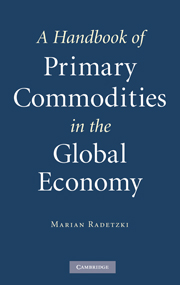Book contents
- Frontmatter
- Contents
- List of figures
- List of tables
- Acknowledgments
- Introduction
- 1 The historical framework
- 2 The geography of commodity production and trade
- 3 Comparative advantage and the trade policy distortions
- 4 Price formation and price trends in commodities
- 5 The commodity exchanges, commodity investments, and speculation
- 6 The economics of exhaustible resource depletion
- 7 Fears of, and measures to assure, supply security
- 8 Producer cartels in international commodity markets
- 9 Public ownership in primary commodity production
- 10 The monoeconomies: issues raised by heavy dependence on commodity production and exports
- References
- Index
5 - The commodity exchanges, commodity investments, and speculation
Published online by Cambridge University Press: 23 June 2009
- Frontmatter
- Contents
- List of figures
- List of tables
- Acknowledgments
- Introduction
- 1 The historical framework
- 2 The geography of commodity production and trade
- 3 Comparative advantage and the trade policy distortions
- 4 Price formation and price trends in commodities
- 5 The commodity exchanges, commodity investments, and speculation
- 6 The economics of exhaustible resource depletion
- 7 Fears of, and measures to assure, supply security
- 8 Producer cartels in international commodity markets
- 9 Public ownership in primary commodity production
- 10 The monoeconomies: issues raised by heavy dependence on commodity production and exports
- References
- Index
Summary
The commodity exchanges and the commodities traded there
Throughout this book, the concept “international commodity markets” is being used in a very loose sense, to describe the buyers and sellers and the transactions they enter into. Commodity markets can be much more strictly defined as places where buyers and sellers of commodities meet to conduct their trade. In all countries there are many such markets of various sizes and levels of sophistication. Local rural markets provide a place for the exchange of food and other agricultural commodities. Nationwide and international markets for specific products or groups of products are also common. Spot transactions with immediate physical delivery usually dominate the trade activities of commodity markets, but there may also be forward deals, involving delivery some time in the future.
The commodity exchanges that are the subject of the present chapter form a small subset of commodity markets. As was made clear in the preceding chapter, this market form has proliferated greatly, both in terms of places where the trade is conducted and in terms of products being subject to trade.
Commodity exchanges are distinguished from other types of markets by having developed particular features in response to a variety of specific needs. They exhibit several distinct characteristics:
Trade is exclusive to a limited membership, but the members of the exchange can conclude deals both on their own behalf and on behalf of their clients. The latter are usually far more important.
Trade used to have the form of open outcry, but in recent times most exchanges have adopted electronic trading. The price of bids to buy is gradually raised, that of offers to sell reduced, until a commonly agreed price is reached.
- Type
- Chapter
- Information
- A Handbook of Primary Commodities in the Global Economy , pp. 86 - 110Publisher: Cambridge University PressPrint publication year: 2008



